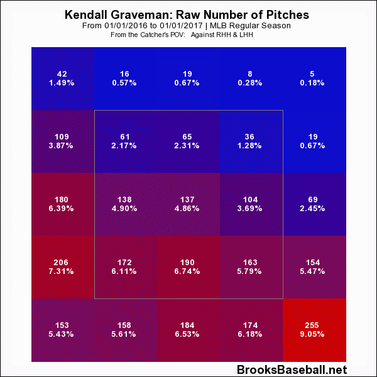If you were out and about on Saturday night, you mightâve missed that Oakland Athletics right-hander Kendall Graveman took a no-hitter into the seventh inning against the Texas Rangers. Mike Napoli broke up the bid with a two-out home-run, but Graveman completed the inning before handing things over to the Aâs bullpen.
What makes Graveman interesting is not that he held the Rangers off the board for most of seven innings, nor that heâs turned into a solid starter since being traded to Oakland in the Josh Donaldson deal. But rather, that this season heâs turned into the simplest pitcher in baseball.
Simple isnât always good for pitchers -- considering how the term âone-pitch pitcherâ is viewed as a pejorative in non-Mariano Rivera cases -- but it seems to be working for Graveman, who is striking out more than eight batters per nine and holding the opposition to a .540 OPS. What about him makes him so simple? It starts with his pitch selection. In his two starts thus far, Graveman has thrown 88 percent sinkers and just 1.6 percent non-fastballs. Compare that to his previous two full seasons, when heâd thrown a higher percentage of curves and changeups (plus cutters, a fastball variation) and itâs fair to write heâs streamlined his process.
That new, uncomplicated nature applies to Gravemanâs location, too. Watch his start against the Rangers and youâll notice him throwing his sinker down and to his glove side over and over. Donât trust your eyes? Consider this chart showing all his pitches thrown this season versus last:


Gravemanâs sinker-heavy approach has allowed him to maintain his groundball rate and has had some unintended benefits, too. Heâs missing more bats this year than before, with his whiff rate jumping more than 10 percentage points, from 18 percent to 29 percent -- that despite locating his pitches inside the strike zone less often. Why is Graveman succeeding? Part of it might be his increased movement -- Brooks Baseball suggests heâs added horizontal movement -- but it also appears heâs manipulating the pitch to give him more variation than it seems:
@harrypav@enosarris don't know if this is obvious or something he normally does pic.twitter.com/8X2tI6vxtw
— Dan Brooks (@brooksbaseball) April 9, 2017
@CarsonDeonS@harrypav@enosarris Hard to imagine he's not. He's got a faster fastball and slower fastball in every inning: pic.twitter.com/AOBUTAI0TL
— Dan Brooks (@brooksbaseball) April 9, 2017
Add it all together over a small sample and Graveman suddenly appears to be a fascinating case study. Can a starting pitcher really succeed by throwing the same pitch in the same general location over and over? Probably not to this extent. Weâll get to find out for sure though.


















